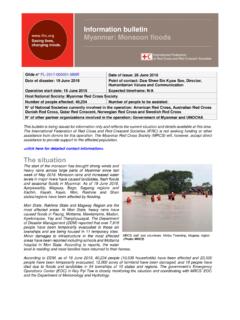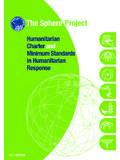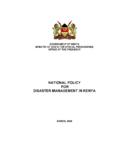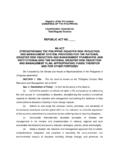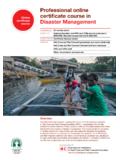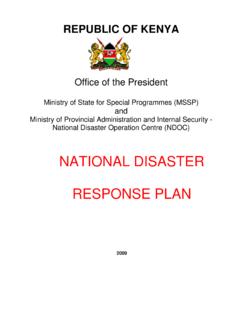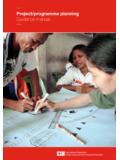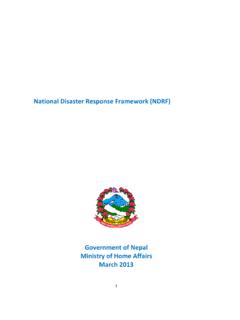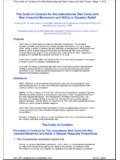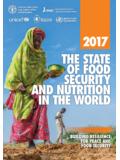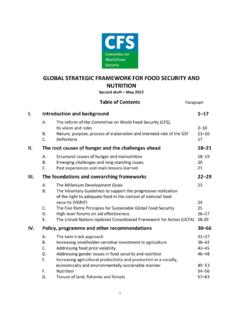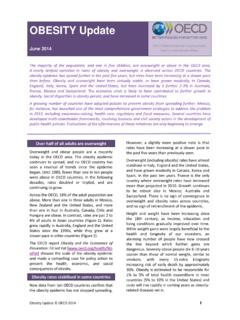Transcription of UNHCR Handbook for Emergencies - IFRC.org - IFRC
1 Handbook for Emergencies UNHCR Handbook for Emergencies United Nations High Commissioner for Refugees Case postale 2500. CH-1211 Gen ve 2 D p t Third Edition Comments on the Handbook for Emergencies and requests for additional Copies should be addressed to: The Emergency Preparedness and Response Section UNHCR Headquarters Case Postale 2500. CH 1211 Gen ve 2 D p t Switzerland T l phone: + 41 22 739 83 01. Fax: + 41 22 739 73 01. Email: Handbook for Emergencies United Nations High Commissioner for Refugees, Geneva Third Edition February, 2007.
2 ISBN. This document is issued by the Office of the United Nations High Commissioner for Refugees for general distribution. All rights are reserved. Reproduction is authorized, except for commercial purposes, provided UNHCR is acknowledged.. Using the Handbook II. Chapters may be located quickly by using the key on the contents page. Particular subjects may be located by using the index. The Handbook is structured as follows: Section One summarizes UNHCR 's mandate of international protecdtion and the aim and principles of emergency response.
3 Section Two deals with emergency management;. Section Three covers the vital sectors and problem areas in refugee Emergencies , including health, food, sanitation and water, as well as key field activities underpinning the operations such as logistics, community services and registration. The chapters in this section start with a summary so that readers, who might not need the full level of detail in each of these chapters, can understand the basic principles of the subject quickly;. Section Four gives guidance on the support to field operations, primarily administration and staffing.
4 The Appendices include a Toolbox which gathers, in one location, the standards, indicators and useful references used throughout the Handbook ;. Key companion references for this Handbook include: Catalogue of Emergency Response Resources which sets out what resources can be immediately deployed to UNHCR emergency operations;. Checklist for the Emergency Administrator which includes many of the essential UNHCR forms, policy documents and guidelines referred to in this Handbook ;. UNHCR Manual, and in particular its Chapter 4 dealing with Operations Management III.
5 IV. Handbook for Emergencies Table of Contents Page Section Chapter Number I Using the Handbook III. II Table of contents V. III Introduction VI. IV UNHCR mission statement X. I. UNHCR principles 1 Aim and principles of response 2 2 Protection 14. II. Emergency management 3 Emergency Management 56 4 Contingency Planning 66 5 Initial Participatory Assessment: immediate response 76 6 Operations Planning 92 7 Coordination and site level organization 100. 8 Implementing arrangements 114. 9 External relations 138. III.
6 Operations 10 Population estimation and registration 154 11 Community Based Approach and Community Services 180 12 Site selection, planning and shelter 204 13 Commodity distribution 226 14 Water 236 15 Sanitation 260 16 Food and nutrition 284 17 Health 336 18 SGBV 376 19 HIV / AIDS 390 20 Education 412 21 Supplies and transport 422 22 Voluntary repatriation 450. IV. Support to operations 23 Administration staffing and finance 466 24 Communications 492 25 Coping with stress 210 26 Staff safety 520 27 Working with the military 532 V.
7 Appendices 1 Toolbox 544 2 Memorandum of understanding with WFP 554 3 Glossary 568 4 Index 570.. Introduction VI. Answering people's urgent need for protection and humanitarian assistance anywhere in the world has been an essential part of UNHCR 's work for the past three decades. Refugees and oth- ers fleeing conflict need help as quickly as possible, requiring a strong institutional commitment to emergency preparedness and response. The international community and public opinion expect aid workers to be on the scene and take action and to do so swiftly.
8 Since 1998, when the second edition of UNHCR 's Emergency Handbook appeared, the Office has been involved in large-scale humanitarian operations in the Great Lakes region of Africa, Timor-Leste, Kosovo, Afghanistan and Pakistan, to name just a few. We have been called on also in many smaller crises where our capacity for timely deployment of staff and aid has saved lives, answered sudden operational shifts and ensured that refugees at risk have received legal and physical protection. This year alone, UNHCR dispatched over 200 emergency staff to 27.
9 Countries on four continents. Developing the mechanisms to reinforce a quick, agile and flexible emergency response capacity is one of our operational priorities for the coming years. We have established an Early Warning system, linking key preparedness measures at country, regional and headquarters levels. Events in Lebanon demonstrated the importance of a robust logistics capacity and, as a result, we have revamped our supply and management service and integrated it in the Division of Operational Services where it will be closely associated with our emergency service.
10 We have increased the number of staff available at any time for immediate deployment. With the collaboration of other humanitarian actors, our target is to be able to respond to unexpected refugee crises involving up to 500,000 people. In addition to traditional emergency skills, evolving situations increasingly demand specific pro- tection and coordination experience. UNHCR is asked to help identify genuine asylum-seekers among the growing groups of new arrivals mixed in with migrants, putting a premium on our abil- ity to deploy qualified staff for protection screening and refugee status determination.
